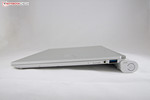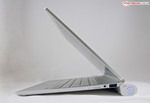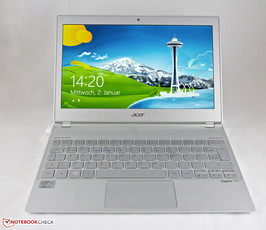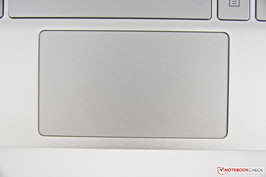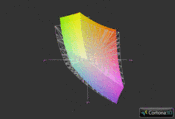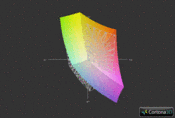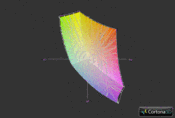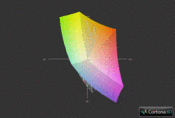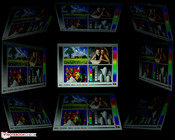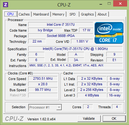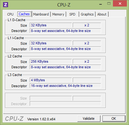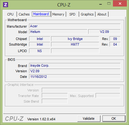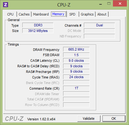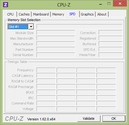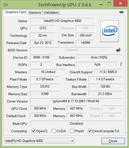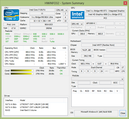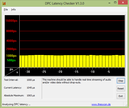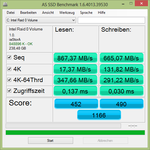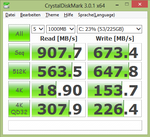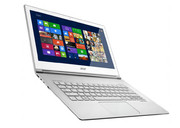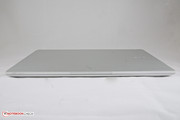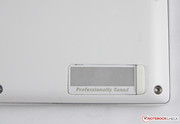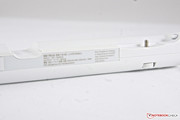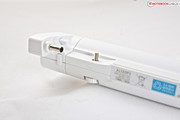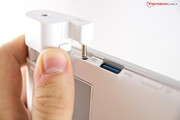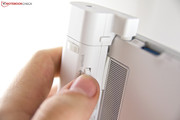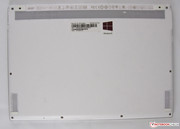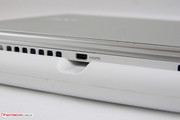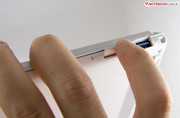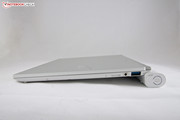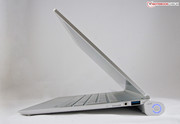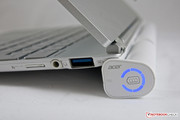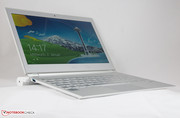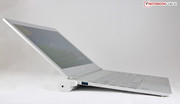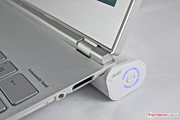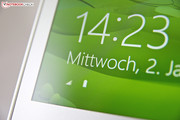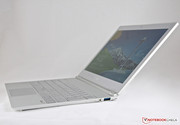Review Acer Aspire S7-191 Ultrabook

For the original German review, see here.
Acer has struggled to make a dent into the PC market for quite some time. Itr was stuck with the reputation of building cheap, poor quality, unreliable notebooks and has been with this stigma for some time. The management decided to make a concentrated effort in revamping the product line in favor of high quality hardware that would cost a bit but would come with almost no compromises. The Aspire in this review is one such device that is aimed at the premium PC market and is one of the first in Acer’s stable to come with the touch-friendly Windows 8 OS.
Acer has already introduced the Aspire S7-391, a 13-inch ultrabook with comparable specifications. It is now the Aspire S7-191 that is put up against fellow 11-inch notebooks that feature premium hardware and are extremely expensive to boot. Being priced between 1300 Euros and 1600 Euros (~$1750 to $2150 depending on the hardware configuration), the laptop comes with a high resolution Full HD IPS display and an innovative clip-on battery to extend battery run times. The laptop battery has a capacity of 28 Wh and the add-on battery doubles it giving the laptop some class leading run times. The other components are normal ultrabook fare. In addition to Intel's Core i7-3517U from the Ivy Bridge generation and 4 GB of DDR3 RAM, a 256 GB SSD storage device is installed. But the surprising bit about the system storage is that it is comprised of two 128 GB SSDs in a RAID 0 array. The older Aspire S5 was designed using a similar concept and was extremely fast in our performance tests.
This notebook has some well established rivals in the ZenBook Prime UX21A and Apple's MacBook Air which has always been a market leader. Both devices feature good quality11.6-inch screens with the Asus including a Full HD IPS screen like in our review sample. If you are looking for a touchscreen in the ultra-portable segment, Asus' VivoBook S200-E, Dell's XPS 12 Convertible or the bigger Aspire S7-391 might be the other options.
Case
Like the 13.3-inch Aspire S7, our 11.6-inch model comes in an impressive case. Unlike its bigger sibling that had a shell that was comprised of magnesium, aluminum and Gorilla Glass II, our test device is based on an aluminum unibody - at least that is how Acer calls it. The slim ultrabook does not look like it has been made of one cast because the base plate is magnesium.
The premium quality and feel of the laptop construction is noticed immediately. The surface has a pleasant velvety finish. The diamond texture on the lid is a very attractive addition to the overall look of the machine. The display is behind a touchscreen made of rigid, but glossy piece of Gorilla Glass (II generation). The other surfaces have a similar velvety finish and look sleek. A nice side effect is that they have a higher resistance to grime and fingerprints than other laptop surfaces.
Do not be fooled by the slim 12.2 mm profile with its minimalistic design. This chassis is every bit as strong and rigid as other machines when subject to the same deforming forces. You will be astonished about how light the laptop seems the first few times when picking it up (1.08 Kg without the secondary battery). The low weight might alarm you at the beginning, but you will find yourself smiling at the form-factor. No creaking noises are heard and nothing warps. The tester often found himself carrying the opened device from one room to another with one hand while surfing on the Internet via gestures with the other just like a tablet. In the other room, the Aspire S7 was again placed on the table or the lap and used in the "laptop" mode, i.e. the keyboard and touchpad were used for navigating around the software. This switch is just as natural as it is easy. There are no hiccups or any irregularities in making this switch - it simply works.
This is also because the two tiny display hinges have two stopping points in their movement. The lid can be opened smoothly up to an opening angle of approximately 95° before the second, firmer break in motion occurs. The hinges provide higher resistance from this point in order to keep the display firmly in position during touch use, which works flawlessly. The small Aspire enables flexible options for almost every work position with its maximum opening angle of approximately 145° - including the tablet-like use described above.
The slim device also rakes in some criticism. Docking the secondary battery is still fairly easy when you have found out how. However, removing it usually ends up with a lot of cursing pointed at the manufacturer. Both securing screws frequently cannot be removed as easily and the user is usually then faced the difficult task of coaxing the battery to detach.
Connectivity
The slim build of the notebook means very little space for the important ports needed by the user. Acer just provides two USB 3.0 ports, a micro HDMI for video output and a 3.5 mm headphone and microphone jack combo for connecting a headset. People who require the SD card slot to transfer images from the camera will have to look at an external solution using one of the USB ports. Like the HDMI port, it has been replaced with a minimized version for tiny micro SD cards used in smartphones. At least one of the two USB ports is powered which allows the user to charge other devices when the laptop is turned off.
Acer had to omit an RJ45 LAN port and a VGA socket due to the extremely slim profile. Instead, these are provided as adapters which plug into the existing USB ports. This might compromise the connectivity options when the adapters are in use. These issues are relatively minor. But we do have to point out that the spacing of the ports is excellent, which would mean that large external devices will not compromise the connectivity options on the laptop.
Communication
Hard wire connections to networks is possible using the supplied USB to Ethernet adapter. However, it only supports transfer speeds up to 100 MB and not Gigabit LAN. Of course, Bluetooth 4.0 and Wi-Fi b/g/n for wireless communication are installed. The Wi-Fi module, the Atheros AR5BWB222, in our test device provided decent transmission rates. Where the module in Lenovo's IdeaPad U410 displayed only 2 of 5 bars in the Wi-Fi signal indicator, our test device exhibited 4 (20 meters and 2 walls separated the devices from the Wi-Fi router). Nevertheless, Acer's lightweight, slim device cannot compete with the flawless Wi-Fi transmission of a MacBook Pro 15.
The built-in webcam has a resolution of 1.3 megapixels and usually provides a balanced picture of middling quality when used for basic video chats.
Accessories
After finding some quick start instructions in the elegant box, a few smaller compartments slowly come to the fore. One is for the ultrabook, beneath which the clip-on secondary battery is found. Above it, an elegant leather sleeve (charcoal black) for the S7 without the secondary battery waits to be unwrapped. Further below that, we find a white Bluetooth mouse and both aforementioned adapters. The power supply unit is in a separate compartment towards one end of the box.
Maintenance
Although only 8 small torqx screws keep the white magnesium base plate secured to the aluminum unibody, the top is fastened with clips. That is actually the standard procedure, but you really have to take care not to make marks on the aluminum edges when releasing the clips. The tester ultimately only looked at the innards through a gap. It was clear that there was no sense in opening the laptop up because nothing could be exchanged or expanded inside. Therefore, we would recommend sparing the aluminum and your nerves.
Warranty
Acer includes a 24 month warranty for the device. This collect & return warranty ensures that the malfunctioning laptop is picked up from the customer. A one year warranty upgrade is available for 89 Euros (~$120)and a two year extension costs 179 (~$240).
Input Devices
Keyboard
The keyboard comes in a silver design which keeps it homogenous with the design of the laptop. The chiclet keyboard is sleek, well made and has a velvety feel to it.
The keys feel just as great as the slightly roughened, matte keyboard base and wrist rest. Both are made from the same piece of aluminum and only a slight recess indicates where the keyboard area begins and the wrist rest ends.
Due to the size and the form factor, the keys have a short drop but are sufficiently well made and forgiving for the user. The keys feature a distinct pressure point and allow for fast and comfortable typing as they are pretty easy to get used to.
However, the layout needs some familiarization at the beginning. The top row of keys for the functions and special features have been combined with the number row. The activation is by combining the necessary key with the FN key. The DEL key replaces the ALT GR key in the German layout, which can get annoying when writing emails. However, it can be triggered by simultaneously pressing the CTRL and ALT key. The caret and degree (^/°) keys have been move to the caps lock key.
Consequently, the user has to spend a lot of time getting the hang of all the combinations available before being able to touch type with good efficiency. The unusual layout did not interfere with the actual typing flow.
Touchpad
The small touchpad is not very broad, but much wider than expected. It is a glass touchpad that supports multi-touch gestures. The entire construction is a giant click pad which has become quite common on many ultrabooks. Its use and precision has reached the high standard of Apple's laptops. The multi-touch gestures supported are the ones commonly available on other ultrabooks. The surface is well-engineered. The finger glides very smoothly over the pad – a good job done by Acer.
Touchscreen
A detailed description of the touchscreen can be found in the review of the identical but larger model. However, our 11.6 inch test device's maximum opening angle of 145° is smaller than the bigger 13.3-inch Aspire S7 (over 180°). Therefore, it is not possible to completely open the screen, which would open some interesting possibilities (group games on a table, etc.).
Display
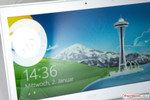
Acer installs a very high-end, 11.6 inch screen that clearly stands out from the masses with its vibrant IPS screen featuring a resolution of 1920 x 1080 pixels (1080p). However, Asus' ZenBook Prime UX21A, Dell's XPS 12 Convertible and Asus' Taichi 21 feature identical specifications on paper. Other paragon ultrabooks like the MacBook Air 11, only provide a 1366 x 768 standard resolution display using the cheaper TN technology. The result being that these laptops are much cheaper. We know that quality has its price. But, we will evaluate whether the screen is really worth it or not.
| |||||||||||||||||||||||||
Brightness Distribution: 93 %
Center on Battery: 187 cd/m²
Contrast: 777:1 (Black: 0.516 cd/m²)
60.7% AdobeRGB 1998 (Argyll 3D)
83.7% sRGB (Argyll 3D)
62.8% Display P3 (Argyll 3D)
The measured data convinced us of the installed IPS screen's quality at first. We were awed by the great image reproduction quality. This is owed to an average maximum brightness of roughly 385 cd/m² and a solid black value of approximately 0.5 cd/m² producing a contrast of up to 814:1 (depending on the ambient light, another reading of 777:1 in another testing unit) and high pixel density (179 ppi).
Those are great brightness rates for the backlight, but they are only achieved in AC mode. The screen only exhibited a maximum brightness of 187 cd/m² on battery power at the time of the hardware test. That is definitely too dim for outdoor use and reflections are also distracting in bright surroundings. This is too bad since that severely restricts the mobility. Hopefully, Acer will soon provide new drivers that increase the brightness that is suitable for outdoor use.
The display completely covers the sRGB color space. Acer's IPS screen (model: CMN 1126) features virtually the same, good color spectrum coverage as Asus' ZenBook Prime UX21A display (model: CMN 1124). The bigger S7 model offer a screen which is slightly poorer in quality compared to the one on its smaller sibling (see screenshots below).
The viewing angle stability is very good owing to the IPS technology being used. A slight color deviation is first noticed from an angle of approximately 80 degrees, which is very good. This can be seen in the screenshot above.
Performance
Our test device features the configuration for around 1500 Euros (~$2000). It sports a swift, energy-efficient Core i7-3517U (2x 1.9 GHz, Turbo up to 3 GHz) including an integrated graphics accelerator (Intel HD Graphics 4000) and 256 GB of storage space. The latter is certainly a special feature of our little Aspire S7 because it is a fast RAID 0 array of two 128 GB SSDs from Lite-On. It displayed extremely short booting times in various tests and will very likely also show good (system) performance in the benchmarks. The laptop comes with 4 GB of DDR3 RAM.
The competition usually feature a single SSD with performance which would be sacrificed in favor of reliability. If you want a touchscreen in a portable but less expensive device, you will have to be content with the much slower Core i3-3217U (2x 1.8 GHz) in the Asus VivoBook S200E. The Dell XPS 12 Convertible sported the faster Core i7-3667U (2x 2 GHz, Turbo up to 3.2 GHz), but most of the rivals will likely use the same processor as in our test device.
Processor
The Core i7-3517U inside our Acer Aspire S7 is the standard Ivy Bridge CPU in most expensive ultrabooks. This energy-efficient ULV processor from Intel is the second fastest of its kind with a TDP of only 17 W. The dual-core processor is clocked at 1.9 GHz and supports Hyper Threading and Turbo Boost (which takes the cores to 3.0 GHz). For an ultra low voltage processor, there is sufficient performance available for demanding workloads (more information here). But the processor doesn’t come with a decent integrated graphics processor for playing games.
We ascertain the processor's performance in computing tasks as well as the Turbo Boost's functionality by running Cinebench R11.5. The Aspire S7-191 did quite a good job here.
Although the Aspire S7 slightly lagged behind the identically equipped competition (including the bigger model) in the multi-core benchmark, it had a marginal performance advantage in the single-core benchmark. Its Turbo Boost proved to be more efficient and almost never deviated from the maximum frequency at just below 3 GHz. We conclude that the disadvantage in multi-core calculation compared with the bigger model is because our little Aspire S7 gets a bit warmer when both processor cores are loaded. Overall, we are very satisfied with the processor's performance.
System Performance
We ran PCMark 7 on the review sample. In addition to the processor, it is the storage device that contributes to the total system performance score. This allows the assessment of the system application performance in image editing, word processing, Internet surfing, video playback and even a 3D acceleration which are actually simulated in this benchmark.
Like the bigger sibling, the little Aspire S7 is a very good performer. It scores a bit lower than the larger laptop and the Asus Taichi 21. The biggest difference to the two laptops in the comparison in the benchmark was in productivity.
However, the laptop is able to post some good results which can be seen below. The ultrabook could surpass the ZenBook UX21A by 15% as well as the equally swift MacBook Air 11 by 19%.
| PCMark 7 Score | 4824 points | |
Help | ||
Storage Devices
The system owes its good performance to the storage device as described above. To be more exact, we are dealing with two SSDs with a capacity of 128 GB each, which come from Lite-On. They are connected in a RAID 0 array in the Aspire S7-191 very similar to the arrangement in the larger 13.3-inch model.
Even though the performance numbers are lower than what is available in the larger device, AS SSD is able to confirm some pretty impressive numbers for the arrangement. The major weakness of the RAID array is the low 4K numbers that measure the data throughput when looking writing these small files onto the disk. It quantifies the performance that you might get when opening programs and boot times. A value of 17 MB/s is pretty poor for an SSD in such a premium device. These numbers need to be much higher to obtain the kind of instantaneous system response a user might expect to input. But the numbers are much better than what you might obtain from conventional mechanical hard drives which produce 4K read rates of below 1 MB/s.
Other than this result, the storage medium was able to produce some really fast numbers that put it near the head of the pack. The SSD array is extremely fast, as the CrystalDiskMark results show (left screenshot).
The higher dropout likelihood of a RAID 0 array should also be noted when using such an arrangement.
Graphics Card
Intel's HD Graphics 4000 is responsible for graphic calculations in the small aluminum ultrabook and is integrated into the processor. This results in lower power consumption than what would be obtained with a dedicated graphics card, but also result in noticeably weaker performance. Nevertheless, the integrated solution is now a very good choice for purposes that exclude playing demanding games in high details. There are no problems when playing quality digital content like Blu Ray quality movies, 1080p YouTube videos, etc (even in energy saving mode).
There are no surprises in 3DMark Vantage. The Aspire produces results that are similar to other laptops with the same hardware. On the other hand, we do note that among the competition, the ZenBook UX21A achieved 11 percentage points more than our review sample in this benchmark.
| 3DMark 06 Standard Score | 4651 points | |
| 3DMark Vantage P Result | 2887 points | |
| 3DMark 11 Performance | 604 points | |
Help | ||
Gaming Performance
Most games like Battlefield 3 cannot be played as they are very dependent on superior graphics hardware. Smooth gameplay is possible only at the lowest settings (for certain older games at least).
The Aspire S7 range with the HD Graphics 4000 is able to run some titles with decent framerates at medium settings. Anno 2070 could still be played fairly smoothly at 20 frames per second in medium details and at a resolution of 1366 x 768 on our test device. Asus' Taichi 21 using the same processor (Core i7-3517U / HD Graphics 4000) only managed a jerky 13 fps. The larger 13-inch model managed 22 fps with the same hardware owing to slightly better cooling.
| low | med. | high | ultra | |
|---|---|---|---|---|
| Anno 2070 (2011) | 43.2 | 20.3 | 12.1 | 6.4 |
| Mass Effect 3 (2012) | 27.4 | 20.1 | 12.3 | |
| Fifa 13 (2012) | 100.4 | 67.2 | 39.1 |
Emissions
System Noise
Our test device has a similar cooling system as the 13-inch version, but a bit smaller. We described this exhaustively in the earlier review article.
Consequently, the little Aspire S7 inherits the larger model’s noise and behavior in addition to the constantly running twin fans. They are usually quiet during normal use, although they are just as high-pitched as in most other laptops. However, the cooling system is comparatively loud during longer periods of load, like in our stress test (46 dB).
Noise level
| Idle |
| 29.7 / 29.7 / 30.5 dB(A) |
| Load |
| 43.2 / 46.7 dB(A) |
 | ||
30 dB silent 40 dB(A) audible 50 dB(A) loud |
||
min: | ||
Temperature
The surface temperatures on both the top and the bottom never surpassed 30°C during normal use (browsing, Office, etc.). Almost all (im)possible working positions are imaginable owing to the cleverly placed vents and the opening angle of approximately 145°. The ultrabook also makes a good impression when used on the lap.
When the laptop is fully loaded for a long period, like in the stress test, the base does heat up a lot to an average temperature of 47.6°C. However, this is not distracting because neither the knees nor the fingers touch this area (a gap of about 3 cm is between the keyboard area and the display hinge). The cooling system is beneath that. This design appears to be well thought out despite the resulting temperatures. We also did not observe throttling which meant no reduction of the CPU clock during full load. The clock rate remained stable at its default clock of 2x 1.9 GHz, like in the larger unit.
(-) The maximum temperature on the upper side is 46.6 °C / 116 F, compared to the average of 35.9 °C / 97 F, ranging from 21.4 to 59 °C for the class Subnotebook.
(-) The bottom heats up to a maximum of 48.6 °C / 119 F, compared to the average of 39.3 °C / 103 F
(+) In idle usage, the average temperature for the upper side is 30 °C / 86 F, compared to the device average of 30.8 °C / 87 F.
(+) The palmrests and touchpad are cooler than skin temperature with a maximum of 31.5 °C / 88.7 F and are therefore cool to the touch.
(-) The average temperature of the palmrest area of similar devices was 28.2 °C / 82.8 F (-3.3 °C / -5.9 F).
Speakers
The Dolby Home Theater certified speakers were also adopted from the bigger unit. A detailed description can be found in its review.
Energy Management
Power Consumption
With a power draw of 6.2 watts going up to about 10 watts, the Aspire consumes a bit more power in idle than the average of a comparable, 11.6-inch ultrabook. The ZenBook Prime UX21A is the leader of energy efficiency here with a very low power consumption range of 4.6 to 9.6 watts.
But the laptop is able to produce some excellent results during the maximum power draw test with a consumption of just 33 watts during full load. There is not much to differentiate this laptop from the other devices with this form factor.
| Off / Standby | |
| Idle | |
| Load |
|
Key:
min: | |
Battery Runtime
Acer’s quest to produce a thin and light device meant the presence of only a 4 cell battery (28 Wh) within the chassis. The option of an add-on battery of similar capacity (28 Wh) was an appropriate solution that allows for the seamless increase in the total runtime of the device. This allows for the doubling of the battery life increasing the mobility of the device at the cost of increasing the weight of the device and affecting the design.
The runtimes obtained with the additional battery are comparable to other devices with the same form factor. The battery lasted for 1 h 49 min in BatteryEater's Classic test at full load and Wi-Fi enabled. It was even 11 h 4 min during low load, using BatteryEater's Reader's test which uses the maximum energy saving settings (disabled wireless modules, minimum brightness). The ultrabook had to be reconnected to the mains after 4 h 7 min when we surfed on the Internet with screen brightness close to 150 cd/m² using Wi-Fi. These are all average rates for compact ultrabooks. However, their batteries usually have lower capacities than the Aspire S7 by at least 10 Wh. The device isn’t really efficient in handling the available resources.
The secondary battery has to be removed to carry the little silver ultrabook around in its charcoal black leather sleeve. The battery capacity is consequently reduced by 28 Wh if it is to be left at home. A runtime of just 2 h 30 min was possible without the clip-on battery in the standardized Wi-Fi test. This is not a good result for such a premium device. The competition is also slim and manage runtimes identical to the Aspire but without a secondary battery.
Verdict

OEMs are still trying to figure out the concept of an ultrabook. Premium devices like the Aspire S7 are high margin devices and they include every quality feature except the kitchen sink while sticking to the strict guidelines set by Intel on what makes an ultrabook. This seems to be a very good fusion of a high quality 1080p display in a slim profile with decent ergonomics.
Acer has an interesting design concept that goes around the problem of low battery life by facilitating the addition of a secondary battery that not only improves battery runtimes, but is also able to improve the typing experience by changing the lay of the laptop. However, we were not completely happy with the implementation. Rivals like the Asus ZenBook Prime UX21A are a few millimeters thicker, but the device runtimes are governed by the internal battery only. And another major problem that a user would have to worry about is the finicky mechanism that connects the battery to the device. The extra moving parts become another cause for concern in the long run.
The screen also leaves mixed feelings. This is an extremely high quality screen with beautiful colors and high brightness (about 400 cd/m2). But these values drop massively to 190 cd/m2 when the laptop is running on the battery. This brightness level is not sufficient to beat the reflections on the screen on a bright sunny day or in a well-lit environment.
The touchscreen works properly, but we like the one in the 13.3-inch Aspire S7 more because the display can be opened further and can be made to lie flat on the table. This opens up the possibility for large number of applications.
Of course, we are nitpicking because the Aspire S7 does a lot of things very well. The flawless, rigid and light aluminum unibody casing, the very compelling application performance and the cooling system that always enables consistent performance without interruptions or slow downs with its twin fans. It also stays fairly quiet in everyday use, with the exception of gaming.
If you do not need a touchscreen, you have the option of the well built ZenBook, and the slower, but beautiful MacBook Air 11. They do not suffer from any major design flaws. They are also 100 to 300 Euros (~$130 to $390) cheaper. If you simply want an affordable, portable laptop with a touchscreen, the Asus VivoBook S200E is available for a competitive price of around 550 Euros (~$740), but with much weaker performance.
If you are looking for the ultimate versatile 11.6 inch ultrabook, keep looking. It doesn’t exist........ yet.





